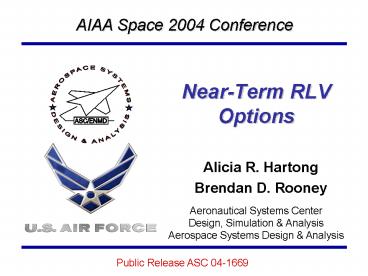NearTerm RLV Options - PowerPoint PPT Presentation
1 / 20
Title:
NearTerm RLV Options
Description:
Surveyed existing rocket engines for performance, availability, ... Engine Throttle. 120/120. 45/23. Nozzle Area Ratio (Base/ATS) 4. 4. Number of Engines. 1.2 ... – PowerPoint PPT presentation
Number of Views:92
Avg rating:3.0/5.0
Title: NearTerm RLV Options
1
Near-Term RLV Options
AIAA Space 2004 Conference
Aeronautical Systems Center Design, Simulation
Analysis Aerospace Systems Design Analysis
2
Outline
- Introduction
- Near-Term Options
- Existing Technologies
- Design Descriptions
- System Weights
- Summary
- Ops-Driven Designs
- Introduction
- Impact of Design on Maintenance
- Impact of Technology on Maintenance
- Design Parameters
- System Weights
- Maintenance Modeling
- Maintenance Estimates
- Summary
3
Introduction
- National Need for Assured Access to Space
- Commercial/Scientific Needs
- Satellite Maintenance
- Space Exploration -gt Presidential Commission 2004
- Military Needs
- Responsive Space
- Intelligence, surveillance and reconnaissance
- Deployment and recovery of microsatellites
- Rapid constellation replenishment
4
Near-Term Options
- PROBLEM
- Given state-of-the-art ST, how much payload,
performance and maintenance burden would a new
reusable launch system provide if development
started immediately? - APPROACH
- Surveyed existing rocket engines for performance,
availability, and maintenance implications. - Talked to TPS technologists about TUFI usability
on a new system. - Modeled TSTO systems using 4 and 5 engine
boosters for payload variability. - Investigated payload carriage options.
- Downselected to 4 cases of interest.
5
Near-Term Options Existing Technologies
- Rockets
- Existing RD-180 RD-120s
- 92 Thrust Setting
- Single Engine-out Capability
- Tanks
- Aluminum / Aluminum-Lithium
- Integral Structure
- Shuttle Based Wt. Est. Relations
- Tanks TPS Structure
- OMS RCS APUs
- Design Margin
- 15 of empty weight except on main engines
RD-180s
RD-120s
6
Near-Term Options Design Description
- Case 1
- Payload (internal carriage) delivered to 270nm
circular orbit _at_ 28.5o east - Case 2
- Payload (internal carriage) delivered to 100nm
circular orbit _at_ 28.5o east - Case 3
- Payload (external module) delivered to 100nm
circular orbit _at_ 28.5o east - Case 4
- Payload (external module) delivered to 100nm
circular orbit _at_ 28.5o east - 2nd Stage NOT sized to return payload
7
Near-Term Options System Weights
1 block 20 ft
Smaller Wing Payload NOT returned
8
Near-Term Options Summary
- Realizable Near-Term System can be achieved
through - Utilization of current technologies
- Existing engines provide required performance
(limited re-use) - TPS mature enough and continuously being improved
- Spiral technology can improve maintenance
timeline - Advanced high temperature windward TPS
- Methane/LOX autogenous pressurization (remove
helium system) - Electric system for actuation (remove hydraulics)
9
Introduction toOps-Driven Design
- Shuttle Orbiter only existing U.S. RLV
- Provides lessons-learned
- Root Cause Analysis identifies maintenance
problem areas - Suggests design for ops to reduce turn-around
time - Ease of access
- Maintenance reduced by
- Limited of system elements
- Unmanned systems
- Long-life, reliable components
- Advanced technologies
- System development
10
Ops-Driven Designs
- PROBLEM
- Given lessons learned from Shuttle maintenance,
can design changes with advanced technologies
significantly improve system maintenance? - APPROACH
- Identified high payoff technologies in
propulsion, thermal protection systems, and
subsystems with AFRL experts. - Designed three systems
- Baseline (not Shuttle) Aluminum structure
(250oF), RD-180-like - Advanced Technology Suite (ATS) New Methane
Propulsion - ATS metallic variant In-718 structure (1200oF)
- Utilized maintenance modeling to measure
technologies effects.
11
Ops-Driven DesignsImpact of Design on
Maintenance
Design changes alone (No Adv. Tech) can reduce
maintenance efforts
12
Ops-Driven Designs Impact of Technology on
Maintenance
Advanced technologies can significantly reduce
maintenance efforts!
13
Ops-Driven Designs Design Parameters
Newly designed ventilated rocket engine nacelles
Consistent Design and Modeling Highlights
Technology Benefits
14
Ops-Driven Designs System Weights
1 block 20 ft
15,000 lb payloads
Aluminum structure
In-718 structure
15
Ops-Driven Designs Maintenance Modeling
- Approach
- Identified major maintenance components
- Identified failure modes their probabilities
- Estimated maintenance manhours
- Model sensitive to technology, design,
development choices - Data Sources
- NASA subject matter experts
- Shuttle technical reports
- Major Maintenance Items
- Thermal Protection Systems (coverage area)
- Windward TPS
- Gap Filler/ Thermal Barriers
- Leeward TPS
- Main Engines (type, number, thrust, quality)
- Engine and Heat Shield Remove/Replace
- Turbopumps
- Engine Function Checks
- Fluid Related Subsystems (type, toxicity, number)
- Main Propulsion Subsystems Feed,
pressurization, control
16
Ops-Driven Designs TPS Maintenance
- ATS system has more durable, easy-to-install TPS
and little to no waterproofing. - ATS-metallic (In-718) minimizes TPS needs.
17
Ops-Driven Designs Main Engine Maintenance
- Baseline uses parametric RD-180s (10 reuses)
- ATS uses parametric methane/lox engine designed
for long-life (20 reuses) - ATS uses ventilated engine nacelle concept
- ATS uses long-life turbopumps
18
Ops-Driven Designs Fluid Related Maintenance
- Baseline uses high pressure helium pressurization
and actuation which requires significant
maintenance function checkouts. - Baseline uses a hydraulic APU
- Baseline RCS/OMS uses toxic hypergols
19
Ops-Driven Designs System Maintenance
Ops-focused Technology, Design and Development
can greatly reduce maintenance!
20
Ops-Driven Designs Summary
- Maintenance improvements seen by
- Simplified system design -gt reduce of large
system elements - Unmanned systems
- Elimination of toxic fluids
- Advanced high temperature blankets
- Common use of Methane/LOX promotes integrated
RCS/OMS/APU subsystems - Elimination of high pressure hydraulics
pneumatics reduces inspections/verifications - Advanced technologies useful in
- reducing the maintenance burden!































